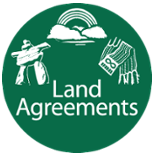Welcome to Land Agreements

Permission: Courtesy of Kristin Moskalyk, Gwenna Moss Centre for Teaching and Learning, Flexible Learning and Technology, based on https://www.canva.com
This chapter provides an opportunity to learn about Métis scrip, Inuit land agreements and nation-to-nation treaty relationships, which is vital in understanding how to honour and respect the agreements. These land agreements are explored within the historical context and understanding from Indigenous peoples perspective, and the implications they have for the Indigenous peoples of Canada.
Honouring Agreements
Treaty promises, land claims and rights have been in dispute between Indigenous peoples and the government since soon after the newcomers arrived. You will examine more in-depth all of the agreements, or understandings-oral, historical, current (economic, social, judicial, governmental, etc.) that exist or are supposed to exist between Indigenous peoples and newcomers. This discussion moves far beyond the written interpretation of particular land agreements, to a reflection, and hopefully, re-envisioning of the relationships between Indigenous peoples and newcomers.
By the end of this chapter you should be able to:
Chapter Outcomes:
- Explain the relationships between Indigenous peoples and the land and how these relationships factor into treaty agreements, land claims, and rights with First Nations, Métis, and Inuit peoples in Canada.
- Demonstrate a solid understanding of treaties in Saskatchewan as oral, written, historical, and contemporary covenants.
- Understand the purpose of, and explain the implementation of, Métis scrip.
- Articulate the general process by which Nunavut was founded and the benefits to the Inuit peoples.
- View land from two or more worldviews to better understand the spirit and intent of land agreements on behalf of Canadian Indigenous peoples.
